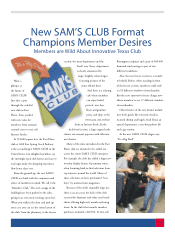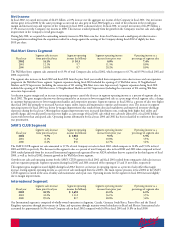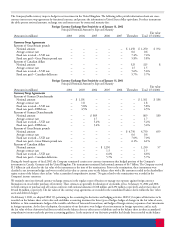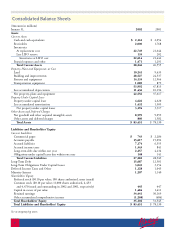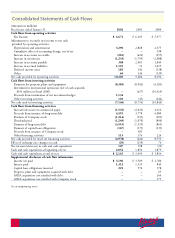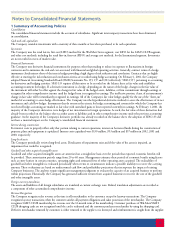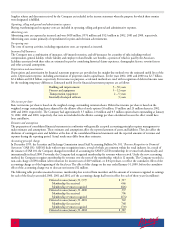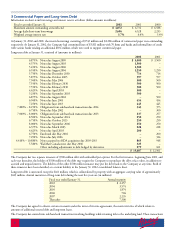Walmart 2002 Annual Report Download - page 24
Download and view the complete annual report
Please find page 24 of the 2002 Walmart annual report below. You can navigate through the pages in the report by either clicking on the pages listed below, or by using the keyword search tool below to find specific information within the annual report.
22
The Company holds currency swaps to hedge its net investment in the United Kingdom. The following tables provide information about our cross-
currency interest rate swap agreements by functional currency, and presents the information in United States dollar equivalents. For these instruments
the tables present notional amounts, exchange rates and interest rates by contractual maturity date.
Foreign Currency Exchange Rate Sensitivity as of January 31, 2002
Principal (Notional) Amount by Expected Maturity
Fair value
(Amounts in millions) 2003 2004 2005 2006 2007 Thereafter Total 1/31/2002
Currency Swap Agreements
Payment of Great Britain pounds
Notional amount – – – – – $ 1,250 $ 1,250 $ 192
Average contract rate – – – – – 0.6 0.6
Fixed rate received – USD rate – – – – – 7.4% 7.4%
Fixed rate paid – Great Britain pound rate – – – – – 5.8% 5.8%
Payment of Canadian dollars
Notional amount – – – – – 325 325 8
Average contract rate – – – – – 1.5 1.5
Fixed rate received – USD rate – – – – – 5.6% 5.6%
Fixed rate paid – Canadian dollar rate – – – – – 5.7% 5.7%
Foreign Currency Exchange Rate Sensitivity as of January 31, 2001
Principal (Notional) Amount by Expected Maturity
Fair value
(Amounts in millions) 2002 2003 2004 2005 2006 Thereafter Total 1/31/2001
Currency Swap Agreements
Payment of German Deutschemarks
Notional amount – $ 1,101 – – – – $ 1,101 $ 186
Average contract rate – 1.8 – – – – 1.8
Fixed rate received – USD rate – 5.8% – – – – 5.8%
Fixed rate paid – DEM rate – 4.5% – – – – 4.5%
Payment of German Deutschemarks
Notional amount – – $ 809 – – – 809 180
Average contract rate – – 1.7 – – – 1.7
Fixed rate received – USD rate – – 5.2% – – – 5.2%
Fixed rate paid – DEM rate – – 3.4% – – – 3.4%
Payment of Great Britain pounds
Notional amount – – – – – $ 4,750 4,750 659
Average contract rate – – – – – 0.6 0.6
Fixed rate received – USD rate – – – – – 7.0% 7.0%
Fixed rate paid – Great Britain pound rate – – – – – 6.1% 6.1%
Payment of Canadian dollars
Notional amount – – – $ 1,250 – – 1,250 57
Average contract rate – – – 1.5 – – 1.5
Fixed rate received – USD rate – – – 6.6% – – 6.6%
Fixed rate paid – Canadian dollar rate – – – 5.7% – – 5.7%
During the fourth quarter of fiscal 2002, the Company terminated certain cross currency instruments that hedged portions of the Company’s
investments in Canada, Germany and the United Kingdom. The instruments terminated had notional amounts of $6.7 billion. The Company received
$1.1 billion in cash related to the fair value of the instruments at the time of the terminations. Prior to the terminations, these instruments were
classified as net investment hedges and were recorded at fair value as current assets on the balance sheet with a like amount recorded in the shareholders’
equity section of the balance sheet in line “other accumulated comprehensive income.” No gain related to the terminations was recorded in the
Company’s income statement.
We routinely enter into forward currency exchange contracts in the regular course of business to manage our exposure against foreign currency
fluctuations on cross-border purchases of inventory. These contracts are generally for durations of six months or less. At January 31, 2002 and 2001,
we held contracts to purchase and sell various currencies with notional amounts of $118 million and $292 million, respectively, and net fair values of
$0 and $6 million, respectively. The fair values of the currency swap agreements are recorded in the consolidated balance sheets within the line “other
assets and deferred charges.”
On February 1, 2001, we adopted SFAS 133 pertaining to the accounting for derivatives and hedging activities. SFAS 133 requires all derivatives to be
recorded on the balance sheet at fair value and establishes accounting treatment for three types of hedges: hedges of changes in the fair value of assets,
liabilities, or firm commitments; hedges of the variable cash flows of forecasted transactions; and hedges of foreign currency exposures of net investments
in foreign operations. At the date of adoption, the majority of our derivatives were hedges of net investments in foreign operations, and as such,
the fair value of these derivatives had been recorded on the balance sheet as either assets or liabilities and on the balance sheet in other accumulated
comprehensive income under the previous accounting guidance. As the majority of our derivative portfolio had already been recorded on the balance


